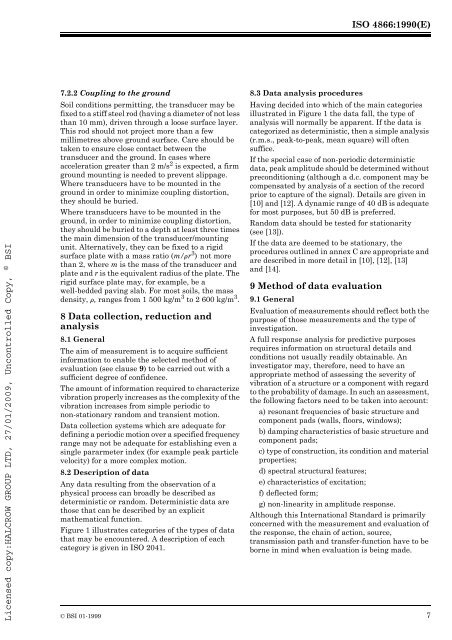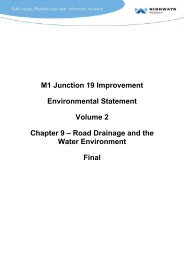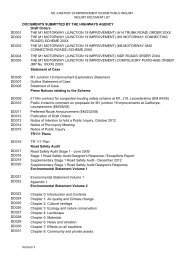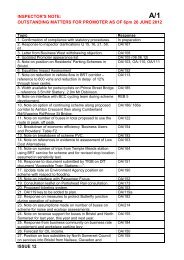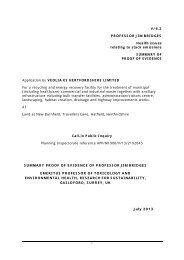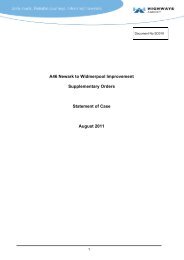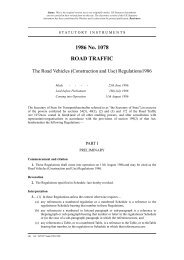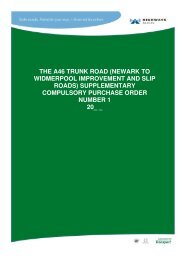Evaluation and Measurement for Vibration in Buildings Part 1, BSI ...
Evaluation and Measurement for Vibration in Buildings Part 1, BSI ...
Evaluation and Measurement for Vibration in Buildings Part 1, BSI ...
Create successful ePaper yourself
Turn your PDF publications into a flip-book with our unique Google optimized e-Paper software.
ISO 4866:1990(E)<br />
Licensed copy:HALCROW GROUP LTD, 27/01/2009, Uncontrolled Copy, © <strong>BSI</strong><br />
7.2.2 Coupl<strong>in</strong>g to the ground<br />
Soil conditions permitt<strong>in</strong>g, the transducer may be<br />
fixed to a stiff steel rod (hav<strong>in</strong>g a diameter of not less<br />
than 10 mm), driven through a loose surface layer.<br />
This rod should not project more than a few<br />
millimetres above ground surface. Care should be<br />
taken to ensure close contact between the<br />
transducer <strong>and</strong> the ground. In cases where<br />
acceleration greater than 2m/s 2 is expected, a firm<br />
ground mount<strong>in</strong>g is needed to prevent slippage.<br />
Where transducers have to be mounted <strong>in</strong> the<br />
ground <strong>in</strong> order to m<strong>in</strong>imize coupl<strong>in</strong>g distortion,<br />
they should be buried.<br />
Where transducers have to be mounted <strong>in</strong> the<br />
ground, <strong>in</strong> order to m<strong>in</strong>imize coupl<strong>in</strong>g distortion,<br />
they should be buried to a depth at least three times<br />
the ma<strong>in</strong> dimension of the transducer/mount<strong>in</strong>g<br />
unit. Alternatively, they can be fixed to a rigid<br />
surface plate with a mass ratio (m/rr 3 ) not more<br />
than 2, where m is the mass of the transducer <strong>and</strong><br />
plate <strong>and</strong> r is the equivalent radius of the plate. The<br />
rigid surface plate may, <strong>for</strong> example, be a<br />
well-bedded pav<strong>in</strong>g slab. For most soils, the mass<br />
density, r, ranges from 1 500 kg/m 3 to 2 600 kg/m 3 .<br />
8 Data collection, reduction <strong>and</strong><br />
analysis<br />
8.1 General<br />
The aim of measurement is to acquire sufficient<br />
<strong>in</strong><strong>for</strong>mation to enable the selected method of<br />
evaluation (see clause 9) to be carried out with a<br />
sufficient degree of confidence.<br />
The amount of <strong>in</strong><strong>for</strong>mation required to characterize<br />
vibration properly <strong>in</strong>creases as the complexity of the<br />
vibration <strong>in</strong>creases from simple periodic to<br />
non-stationary r<strong>and</strong>om <strong>and</strong> transient motion.<br />
Data collection systems which are adequate <strong>for</strong><br />
def<strong>in</strong><strong>in</strong>g a periodic motion over a specified frequency<br />
range may not be adequate <strong>for</strong> establish<strong>in</strong>g even a<br />
s<strong>in</strong>gle pararmeter <strong>in</strong>dex (<strong>for</strong> example peak particle<br />
velocity) <strong>for</strong> a more complex motion.<br />
8.2 Description of data<br />
Any data result<strong>in</strong>g from the observation of a<br />
physical process can broadly be described as<br />
determ<strong>in</strong>istic or r<strong>and</strong>om. Determ<strong>in</strong>istic data are<br />
those that can be described by an explicit<br />
mathematical function.<br />
Figure 1 illustrates categories of the types of data<br />
that may be encountered. A description of each<br />
category is given <strong>in</strong> ISO 2041.<br />
8.3 Data analysis procedures<br />
Hav<strong>in</strong>g decided <strong>in</strong>to which of the ma<strong>in</strong> categories<br />
illustrated <strong>in</strong> Figure 1 the data fall, the type of<br />
analysis will normally be apparent. If the data is<br />
categorized as determ<strong>in</strong>istic, then a simple analysis<br />
(r.m.s., peak-to-peak, mean square) will often<br />
suffice.<br />
If the special case of non-periodic determ<strong>in</strong>istic<br />
data, peak amplitude should be determ<strong>in</strong>ed without<br />
precondition<strong>in</strong>g (although a d.c. component may be<br />
compensated by analysis of a section of the record<br />
prior to capture of the signal). Details are given <strong>in</strong><br />
[10] <strong>and</strong> [12]. A dynamic range of 40 dB is adequate<br />
<strong>for</strong> most purposes, but 50 dB is preferred.<br />
R<strong>and</strong>om data should be tested <strong>for</strong> stationarity<br />
(see [13]).<br />
If the data are deemed to be stationary, the<br />
procedures outl<strong>in</strong>ed <strong>in</strong> annex C are appropriate <strong>and</strong><br />
are described <strong>in</strong> more detail <strong>in</strong> [10], [12], [13]<br />
<strong>and</strong> [14].<br />
9 Method of data evaluation<br />
9.1 General<br />
<strong>Evaluation</strong> of measurements should reflect both the<br />
purpose of those measurements <strong>and</strong> the type of<br />
<strong>in</strong>vestigation.<br />
A full response analysis <strong>for</strong> predictive purposes<br />
requires <strong>in</strong><strong>for</strong>mation on structural details <strong>and</strong><br />
conditions not usually readily obta<strong>in</strong>able. An<br />
<strong>in</strong>vestigator may, there<strong>for</strong>e, need to have an<br />
appropriate method of assess<strong>in</strong>g the severity of<br />
vibration of a structure or a component with regard<br />
to the probability of damage. In such an assessment,<br />
the follow<strong>in</strong>g factors need to be taken <strong>in</strong>to account:<br />
a) resonant frequencies of basic structure <strong>and</strong><br />
component pads (walls, floors, w<strong>in</strong>dows);<br />
b) damp<strong>in</strong>g characteristics of basic structure <strong>and</strong><br />
component pads;<br />
c) type of construction, its condition <strong>and</strong> material<br />
properties;<br />
d) spectral structural features;<br />
e) characteristics of excitation;<br />
f) deflected <strong>for</strong>m;<br />
g) non-l<strong>in</strong>earity <strong>in</strong> amplitude response.<br />
Although this International St<strong>and</strong>ard is primarily<br />
concerned with the measurement <strong>and</strong> evaluation of<br />
the response, the cha<strong>in</strong> of action, source,<br />
transmission path <strong>and</strong> transfer-function have to be<br />
borne <strong>in</strong> m<strong>in</strong>d when evaluation is be<strong>in</strong>g made.<br />
© <strong>BSI</strong> 01-1999 7


